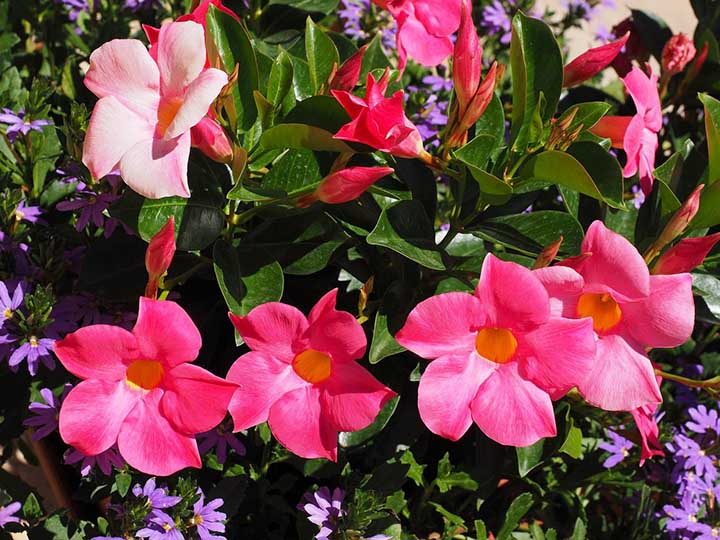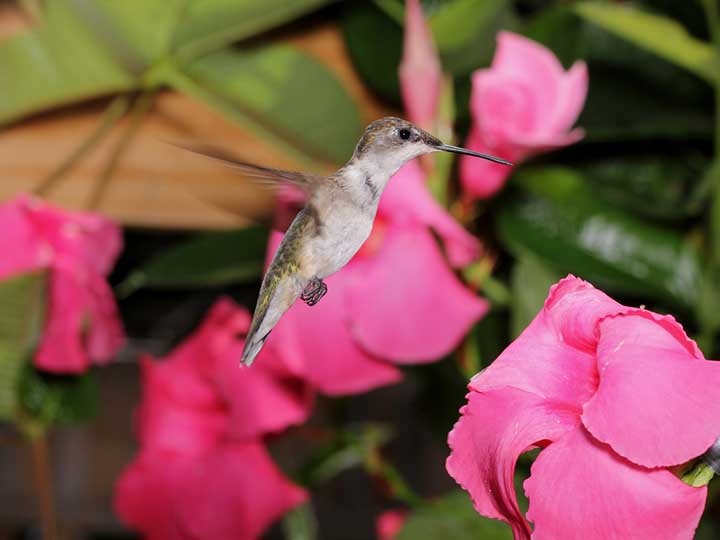Flowers like Bee Balm, Daylilies, and Inpatients are known the world over for their ability to attract hummingbirds, butterflies, and bees.
But what about beautiful vining flower species like Mandevilla and Dipladenia?
Do Mandevilla and Dipladenia attract hummingbirds, butterflies, and bees?
Mandevilla and Dipladenia are well-known species for attracting pollinators of all shapes and sizes. Hummingbirds, butterflies, and bees are among the most helpful species that these two flowers draw to themselves.
Read on below and learn everything you need to know about Mandevilla and Dipladenia attracting hummingbirds, butterflies, and bees!
Table of Contents
Do Hummingbirds, Butterflies, and Bees Like Mandevilla?
Hummingbirds are wildly attracted to the bright colors of the flowering vine, Mandevilla. They enjoy the sweet-tasting nectar of the plant and find its tube-shaped flowers a perfect chalice to drink from.
Bees are among the most helpful insects that are drawn to the flowers of the Mandevilla vine, pollinating them alongside hummingbirds and other beneficial species that frequent the fragrant species.
Butterflies also enjoy visiting the Mandevilla plants in your yard.
They aren’t quite as talented at pollinating things as bees, or hummingbirds, but they definitely give it their best shot (and do indeed help to pollinate Mandevilla and surrounding flowers during the day).
Do Hummingbirds, Butterflies, and Bees Like Dipladenia?
Dripladenia, like Mandevilla, has vivid colored flowers with a tubular structure that are wildly attractive to pollinators like hummingbirds.
The species may not get as tall as Mandevilla does, but it is every bit as seductive to pollinators.
Dipladenia is known for bright pink flowers that attract all sorts of beneficial insects, including pollinating butterflies, as soon as they start blooming each year.
Bees and other pollinators are also all over Dipladenia once the plants begin to put off blooms.
Planting other fragrant plowers nearby your Dipladenia, such as Bee Balm, is a sure way to bring in pollinators from all over the neighborhood.
Why Hummingbirds, Butterflies, and Bees Like Mandevilla and Dipladenia?
Hummingbirds are attracted to flowers such as Mandevilla and Dipladenia for a couple of significant reasons. The extra strong aroma of the flowers is the first attractant to hummingbirds.
The second major attractant that brings the hummingbirds flying to Mandevilla and Dipladenia is the vivid colors of the flowers themselves.
In addition, once in the area checking things out, the tube-like shape of the flowers is the final attractant.
The shape of the flowers fits hummingbirds’ beak (which they drink from) perfectly, making them a favorite plant for the species to feed on when they have the chance.
Bees, butterflies, and other beneficial pollinating species are attracted to Mandevilla and Dipladenia plants for the same reasons as hummingbirds (minus the shape of the flowers); the strong smell, the bright colors, the sweet nectar, and the pollen.
Where is the Best Place to Plant so They Will Attract More Hummingbirds, Butterflies, and Bees?

Planting your Mandevilla and/or Dipladenia in the right location is key to attracting hummingbirds, butterflies, bees, and other pollinators.
Below, we break down the best locations for each of the flower species:
Best Place to Plant Mandevilla for Attracting Pollinators
The best place to plant your Mandevilla, for attracting pollinators, is somewhere they are brightly lit, well-drained, and have plenty of room for airflow.
Hummingbirds prefer somewhere out of the direct sunlight, so keep this in mind when planting.
Somewhere that has plenty of full sunlight is fine, just make sure the location also has some shade in the morning, afternoon, or evening, if you want to attract hummingbirds.
Leaving space around the Mandevilla, for positive airflow, is crucial for attracting pollinators like butterflies, hummingbirds, and bees.
This airflow is what carries the sweet aroma of the flowers out into the surrounding area, without it, your plants will have fewer pollinating visitors.
Best Place to Plant Dipladenia for Attracting Pollinators
Like Mandevilla, Dipladenia is best planted somewhere in your yard, garden, or pots, where it receives several hours of bright sunlight, yet also enjoys some bit of shade during the day as well.
Without proper lighting, the flowers won’t bloom as nicely, if at all, and therefore the plant won’t attract as many pollinators.
Likewise, if the plant has too much sunlight, and not enough shade, or time receiving partial sunlight, it won’t be as inviting to species like hummingbirds who enjoy shade more than hot sunlight.
So long as your Dipladenia has blooming flowers, and airflow, bees, butterflies, and other helpful insects that help the pollination process will easily find your flowers.
When Do Hummingbirds, Butterflies, and Bees Like to Visit Mandevilla and Dipladenia?
Flowers like Mandevilla and Dipladenia have all the right characteristics for attracting scores of pollinators; they are extra fragrant, bloom more than once per year if cared for well enough, and have bright and vivid flower petals.
However, the best times to catch pollinators visiting your Mandevilla and/or Dipladenia vary.
Below, we discuss what time of day the various common pollinator species visit Mandevilla and Dipladenia:
What Time of Day do Hummingbirds Visit?
Hummingbirds are known for avoiding direct sunlight and the hot temperatures that often accompany it.
That’s why the best time of day to see hummingbirds visiting your flowers is typically early in the morning or late in the evening before sunlight.
In other words, dawn and dusk are the two most common times for hummingbirds to visit.
What Time of Day do Butterflies Visit?
Butterflies, unlike hummingbirds, can be spotted visiting your Mandevilla, Dipladenia, and other common flowers at all hours of the day.
The most active time of the day for butterflies is between noon and 4 pm, and the hotter parts of the day.
It is more than likely the high heat of the middle day that causes butterflies to temporarily become more active.
All things considered, you are likely to catch butterflies on your Mandevilla and Dipladenia from dawn until dusk, and all hours in between.
What Time of Day Do Bees Visit?
Bees, much like butterflies, become extremely active during the middle of the day (typically between noon and 4 pm).
During the hottest and sunniest parts of the day, you are the most likely to catch bees visiting your Mandevilla and Dipladenia, and other flowers.
That said, you may see bees visiting your flowers at all hours of the day, save for at night when they are usually totally inactive.
Conclusion
Mandevilla and Dipladenia flowers not only attract hummingbirds, butterflies, and bees, they do so with ease.
Thanks to their vivid pinks, reds, and whites, as well as their potent aroma, beneficial pollinators like bees, butterflies, and yes, hummingbirds, can’t resist these little trumpet-shaped flowers full of juicy nectar and sweet pollen.
If you want to ensure a large number of pollinators are attracted to your Mandevilla and Dipladenia, try giving them some companions such as Bee Balm, Impatiens, and Daylilies.
